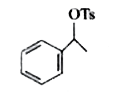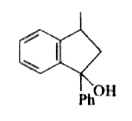Lucas reagent is:
Anhydrous ZnCl2+HCl(conc.)
MnO2+H2O
H2SO4+HCl
NO+H2O
The correct Answer is:A
Step-by-Step Solution:
1. Understanding Lucas Reagent: Lucas reagent is a chemical reagent used primarily in organic chemistry to differentiate between primary, secondary, and tertiary alcohols.
2. Components of Lucas Reagent: The Lucas reagent is composed of anhydrous zinc chloride (ZnCl2) and concentrated hydrochloric acid (HCl).
3. Purpose of Lucas Reagent: The main purpose of Lucas reagent is to distinguish between different types of alcohols. When alcohols react with Lucas reagent, the reaction rate varies based on the type of alcohol:
- Tertiary alcohols react quickly, leading to the formation of an alkyl chloride.
- Secondary alcohols react more slowly.
- Primary alcohols do not react at room temperature.
4. Identifying the Correct Option: Based on the components and purpose of Lucas reagent, the correct answer is that Lucas reagent is a mixture of anhydrous ZnCl2 and concentrated HCl.
5. Conclusion: Therefore, the correct option is the first one, which states that Lucas reagent is anhydrous ZnCl2 along with concentrated HCl.
---
- Tertiary alcohols react quickly, leading to the formation of an alkyl chloride.
- Secondary alcohols react more slowly.
- Primary alcohols do not react at room temperature.
Topper's Solved these Questions
- D BLOCK ELEMENTSBOOK - RESONANCE ENGLISHCHAPTER - D BLOCK ELEMENTSEXERCISE - EXERCISE-2 PART-IV
7 Videos
- D BLOCK ELEMENTSBOOK - RESONANCE ENGLISHCHAPTER - D BLOCK ELEMENTSEXERCISE - EXERCISE-3 PART-I
15 Videos
- D BLOCK ELEMENTSBOOK - RESONANCE ENGLISHCHAPTER - D BLOCK ELEMENTSEXERCISE - EXERCISE-2 PART-I
27 Videos
- D & F BLOCK ELEMENTSBOOK - RESONANCE ENGLISHCHAPTER - D & F BLOCK ELEMENTSEXERCISE - ORGANIC CHEMISTRY(Aldehydes , Ketones, Carboxylic acid)
15 Videos
- DPPBOOK - RESONANCE ENGLISHCHAPTER - DPPEXERCISE - QUESTIONS
368 Videos
Similar Questions

X gives white turbidity with Lucas reagent instantly. X and Y both turn blue litmus solution red. Y can be:
View SolutionX' is a smallest optically active alkanol. On dehydration it can form Y number of alkenes (including stereoisomers). On reaction with Lucas reagent it forms Z number of alkyl halides (including stereoisomers). Report your answer as ZY.
View Solution
Knowledge Check
An organic compound (A)C8H10O was subjected to a series of test in laboratory.
It was found that this compound :
(i) Rotates the plane polarized light.
(ii) Evolves H2 gas with Na.
(iii) Reaches with I2 and NaOH to produce yellow ppt.
(iv) Does not react with Br2/CCl4
(v) Reacts with hot KMnO4 to form (B)C7H6O2, which can also be synthesized by benzene and carbonyl chloride followed by hydrolysis.
(vi) Loses optical acitvity as a result of reduction with Red P+Hi to form C.
(vii) Reacts with Lucas reagent in about 5 minutes.
Find out structure of compound A:A B
B C
C D
D
An organic compound (A)C8H10O was subjected to a series of test in laboratory.
It was found that this compound :
(i) Rotates the plane polarized light.
(ii) Evolves H2 gas with Na.
(iii) Reaches with I2 and NaOH to produce yellow ppt.
(iv) Does not react with Br2/CCl4
(v) Reacts with hot KMnO4 to form (B)C7H6O2, which can also be synthesized by benzene and carbonyl chloride followed by hydrolysis.
(vi) Loses optical acitvity as a result of reduction with Red P+Hi to form C.
(vii) Reacts with Lucas reagent in about 5 minutes.
ATsCl−−→Xalc.KOH−−−−−→YConc.H2SO4−−−−−−−→Z
Find out correct structure of Z.A B
B C
C D
D
An organic compound (A)C8H10O was subjected to a series of test in laboratory.
It was found that this compound :
(i) Rotates the plane polarized light.
(ii) Evolves H2 gas with Na.
(iii) Reaches with I2 and NaOH to produce yellow ppt.
(iv) Does not react with Br2/CCl4
(v) Reacts with hot KMnO4 to form (B)C7H6O2, which can also be synthesized by benzene and carbonyl chloride followed by hydrolysis.
(vi) Loses optical acitvity as a result of reduction with Red P+Hi to form C.
(vii) Reacts with Lucas reagent in about 5 minutes.
Compounds B and C are respectively:A B
B C
C D
D
An organic compound does not react appreciably with Lucas reagent but give white precipitate with Tollen's reagent. Which is the possible structure of compound ?
View SolutionWhy is the reactivity of all the three classes of alcohols with conc. HCl and ZnCl2 (Lucas reagent) different ?
View SolutionHow many alcohols give immediate turbidity with Lucas reagent having molecular formula (C5H12O) :
View SolutionThe compound that reacts fastest with Lucas reagent at room temperature is
View SolutionThe compound which reacts fastest with Lucas reagent at room temperature is
View Solution
